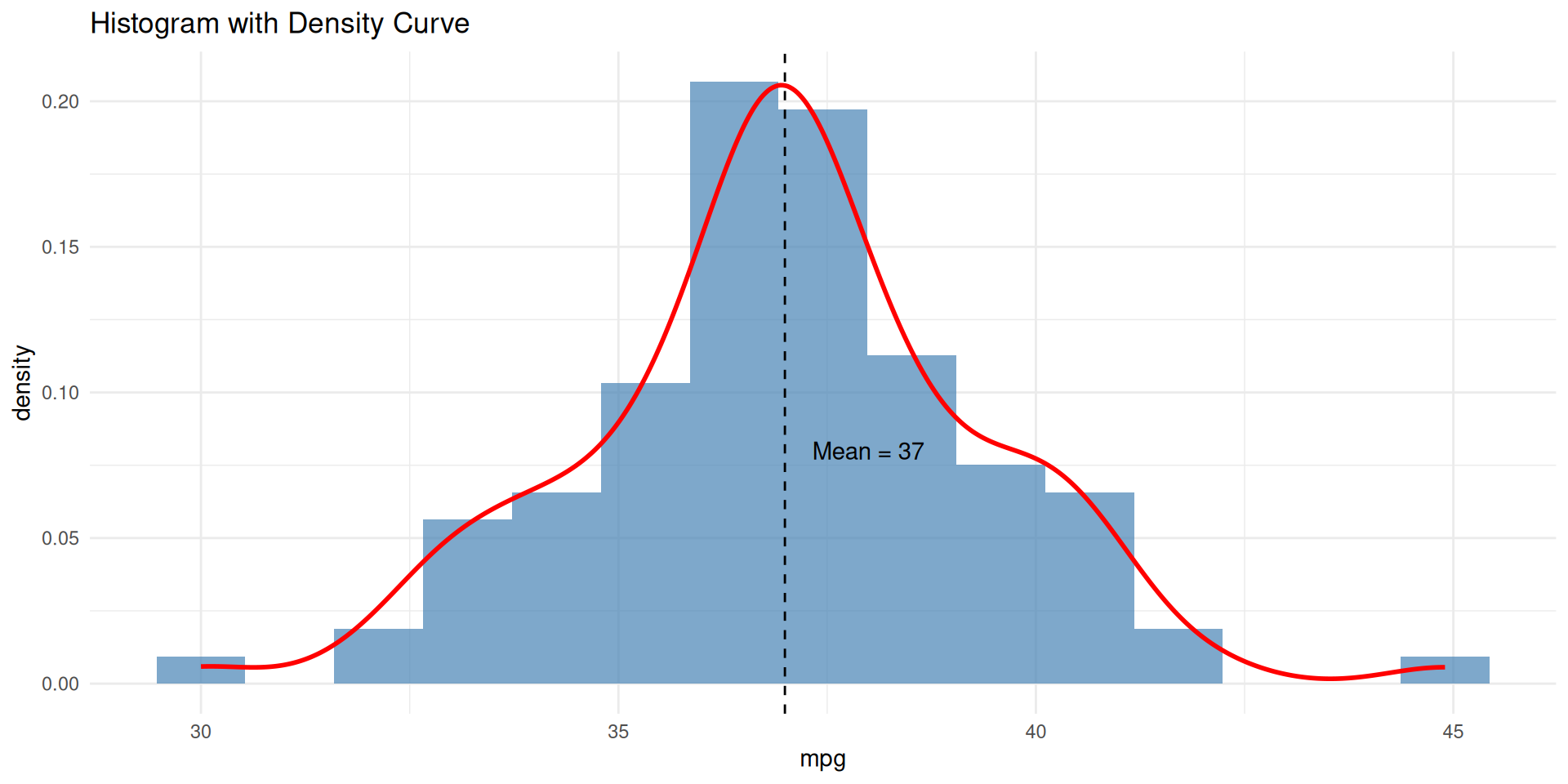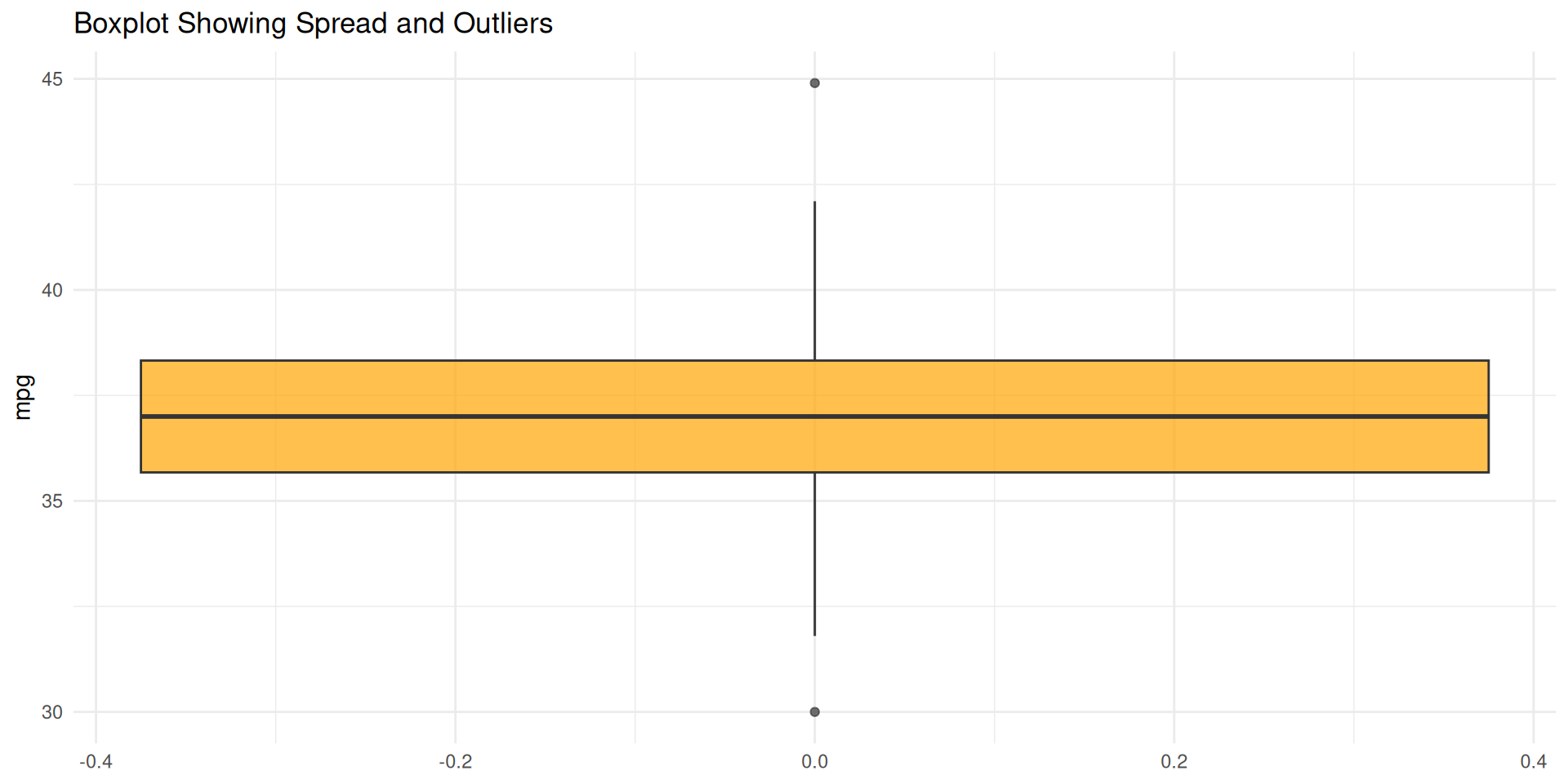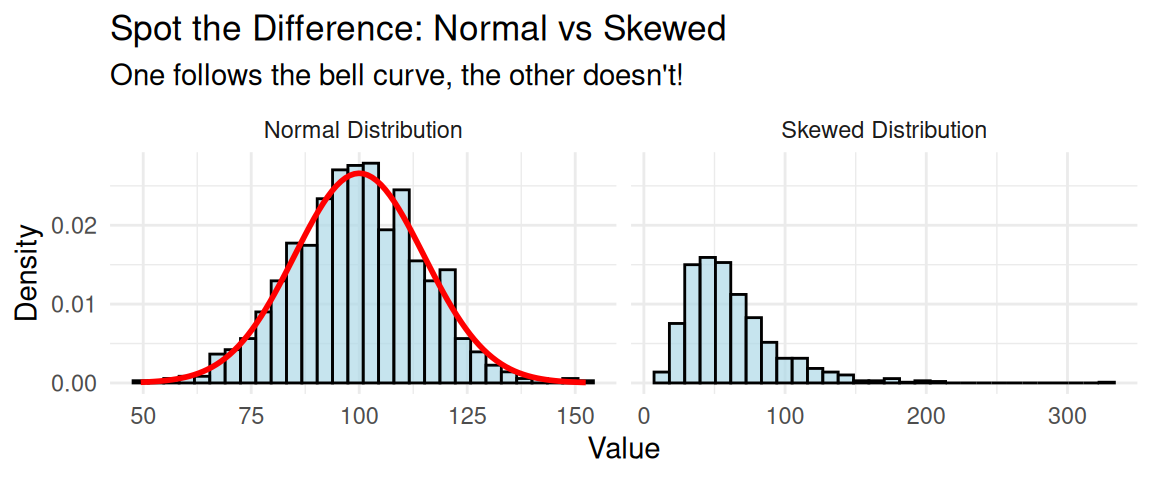
Day 13
Math 216: Statistical Thinking
Why Normality Assessment Matters
Think about it: You assume your data is normal when using statistical tests, but what if it’s not? Your conclusions could be completely wrong! It’s like using a ruler to measure temperature - wrong tool, wrong results.
Theory Vs. Reality: When Normal Goes Wrong
- Normal: Symmetric bell shape, balanced tails
- Skewed: Stretched tail on one side - clues to non-normality!
The Danger: Using normal-based tests on skewed data = unreliable results
Three Powerful Methods to Catch Non-Normality:
- Visual Detective Work: Plots reveal hidden patterns
- Empirical Rule Check: Does 68-95-99.7% rule hold?
- IQR/SD Ratio Test: Quick numerical check (should ≈ 1.3)
Remember: One method isn’t enough - use them together like detective tools!
Visual Detective Work: Spot the Clues!
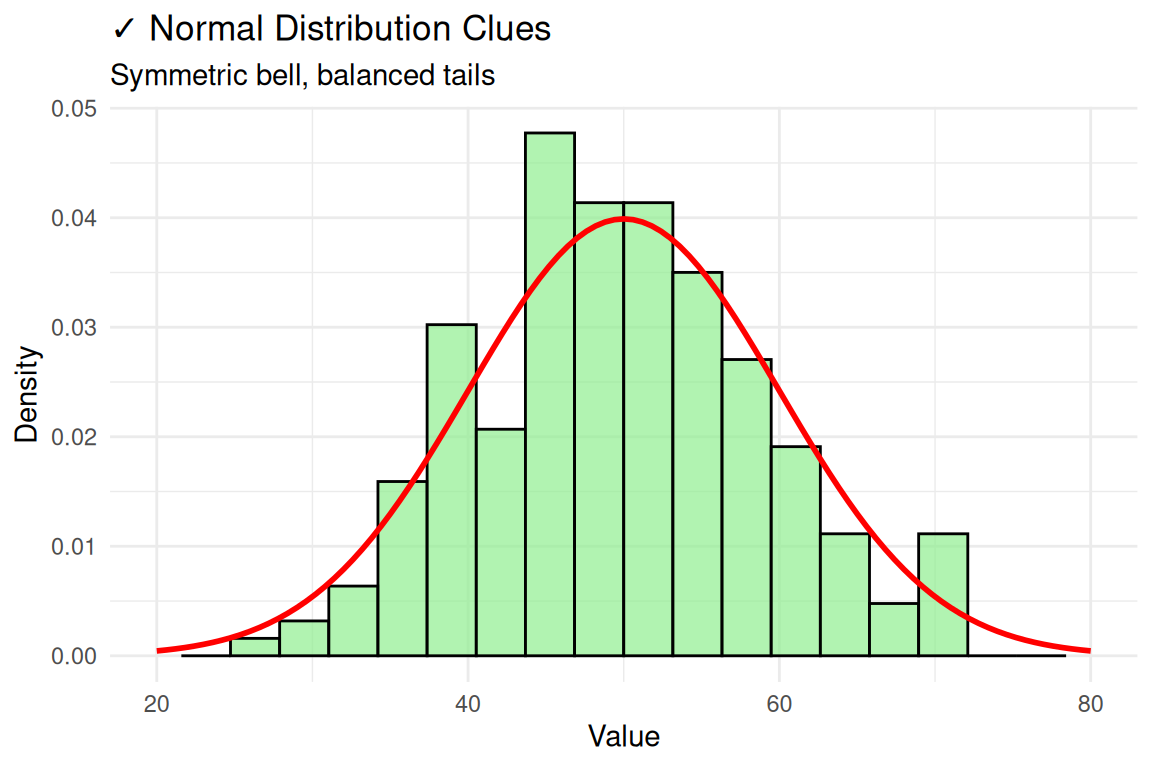
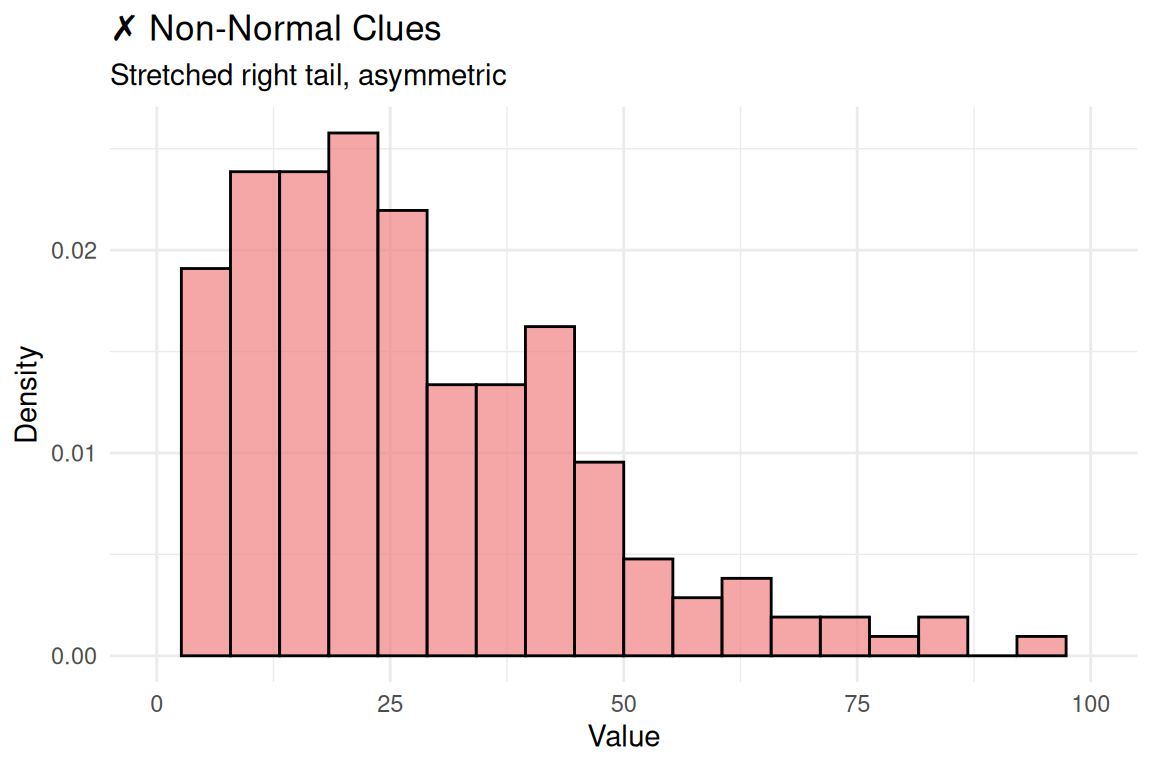
The 3-Step Normality Test
Step 1: Visual Inspection (30 seconds)
- Histogram: Bell-shaped? Symmetric?
- Q-Q Plot: Points on diagonal?
Step 2: Empirical Rule Check (1 minute)
- 68% within μ ± 1σ?
- 95% within μ ± 2σ?
- 99.7% within μ ± 3σ?
Step 3: IQR/SD Ratio (30 seconds)
- Calculate: IQR ÷ SD
- Normal data: Ratio ≈ 1.3
- Far from 1.3? Red flag!
Quick Rule: If any step fails → investigate further!
Case Study: EPA ratings
The dataset consists of EPA gas mileage ratings for 100 cars. Each value represents the miles per gallon (MPG) that a particular car achieves under standardized testing conditions. This dataset can help understand how statistical methods are applied in real-world scenarios like assessing the fuel efficiency of vehicles.
EPA Gas Mileage Ratings for 100 Cars (miles per gallon)
| col1 | col2 | col3 | col4 | col5 | col6 | col7 | col8 | col9 | col10 |
|---|---|---|---|---|---|---|---|---|---|
| 36.3 | 41.0 | 36.9 | 37.1 | 44.9 | 36.8 | 30.0 | 37.2 | 42.1 | 36.7 |
| 32.7 | 37.3 | 41.2 | 36.6 | 32.9 | 36.5 | 33.2 | 37.4 | 37.5 | 33.6 |
| 40.5 | 36.5 | 37.6 | 33.9 | 40.2 | 36.4 | 37.7 | 37.7 | 40.0 | 34.2 |
| 36.2 | 37.9 | 36.0 | 37.9 | 35.9 | 38.2 | 38.3 | 35.7 | 35.6 | 35.1 |
| 38.5 | 39.0 | 35.5 | 34.8 | 38.6 | 39.4 | 35.3 | 34.4 | 38.8 | 39.7 |
| 36.3 | 36.8 | 32.5 | 36.4 | 40.5 | 36.6 | 36.1 | 38.2 | 38.4 | 39.3 |
| 41.0 | 31.8 | 37.3 | 33.1 | 37.0 | 37.6 | 37.0 | 38.7 | 39.0 | 35.8 |
| 37.0 | 37.2 | 40.7 | 37.4 | 37.1 | 37.8 | 35.9 | 35.6 | 36.7 | 34.5 |
| 37.1 | 40.3 | 36.7 | 37.0 | 33.9 | 40.1 | 38.0 | 35.2 | 34.8 | 39.5 |
| 39.9 | 36.9 | 32.9 | 33.8 | 39.8 | 34.0 | 36.8 | 35.0 | 38.1 | 36.9 |
# store 100 mpgs in an object called 'mpg'
mpg <- c(
36.3, 41.0, 36.9, 37.1, 44.9, 36.8, 30.0, 37.2, 42.1, 36.7,
32.7, 37.3, 41.2, 36.6, 32.9, 36.5, 33.2, 37.4, 37.5, 33.6,
40.5, 36.5, 37.6, 33.9, 40.2, 36.4, 37.7, 37.7, 40.0, 34.2,
36.2, 37.9, 36.0, 37.9, 35.9, 38.2, 38.3, 35.7, 35.6, 35.1,
38.5, 39.0, 35.5, 34.8, 38.6, 39.4, 35.3, 34.4, 38.8, 39.7,
36.3, 36.8, 32.5, 36.4, 40.5, 36.6, 36.1, 38.2, 38.4, 39.3,
41.0, 31.8, 37.3, 33.1, 37.0, 37.6, 37.0, 38.7, 39.0, 35.8,
37.0, 37.2, 40.7, 37.4, 37.1, 37.8, 35.9, 35.6, 36.7, 34.5,
37.1, 40.3, 36.7, 37.0, 33.9, 40.1, 38.0, 35.2, 34.8, 39.5,
39.9, 36.9, 32.9, 33.8, 39.8, 34.0, 36.8, 35.0, 38.1, 36.9
)
mpg_data <- data.frame(mpg = mpg)Visualization Approach
Normality Assessment
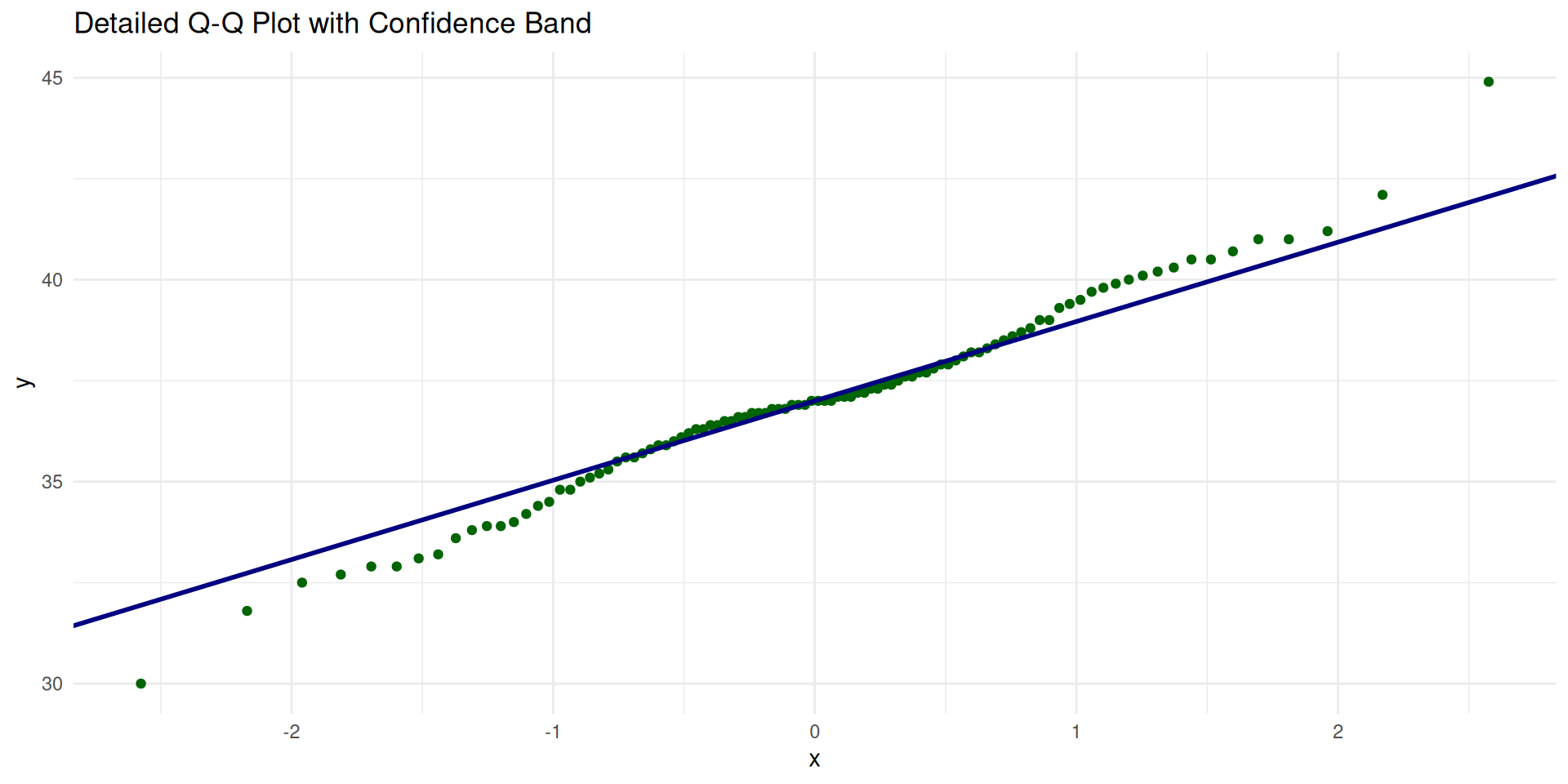
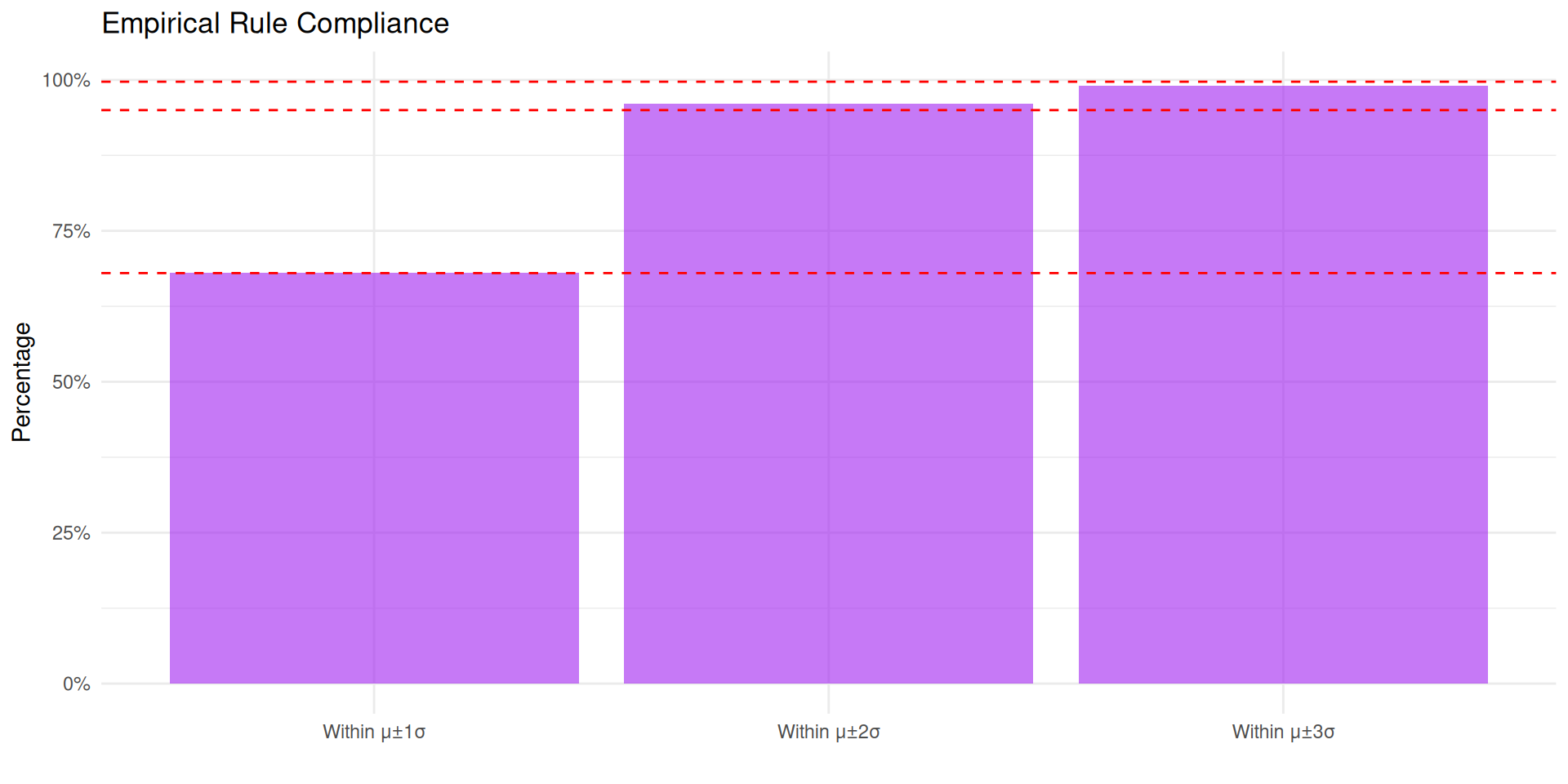
| IQR | SD | Ratio | Expected | Difference |
|---|---|---|---|---|
| 2.65 | 2.42 | 1.1 | 1.3 | -0.2 |
Reading Q-Q Plots: A Detailed Example
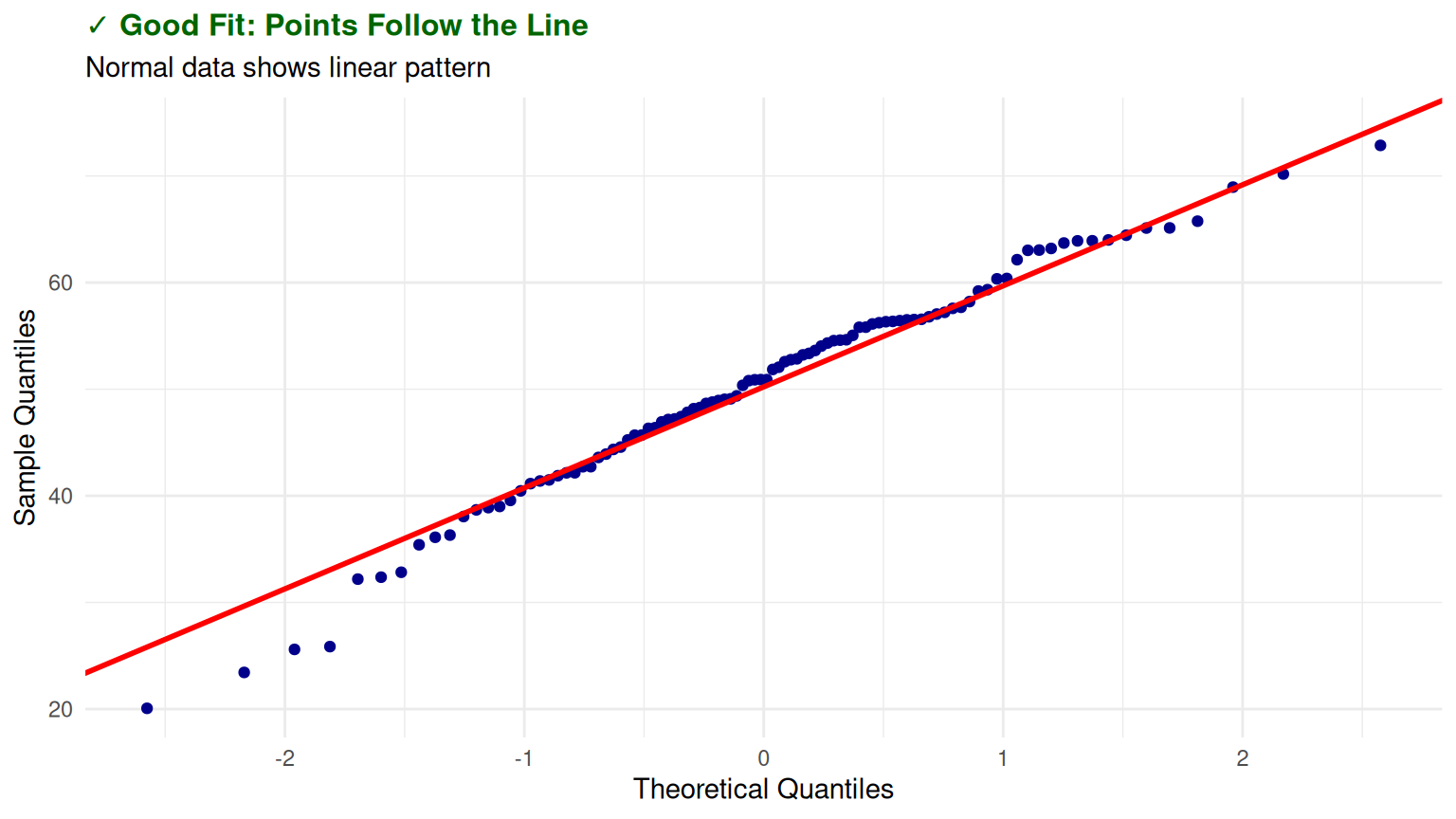
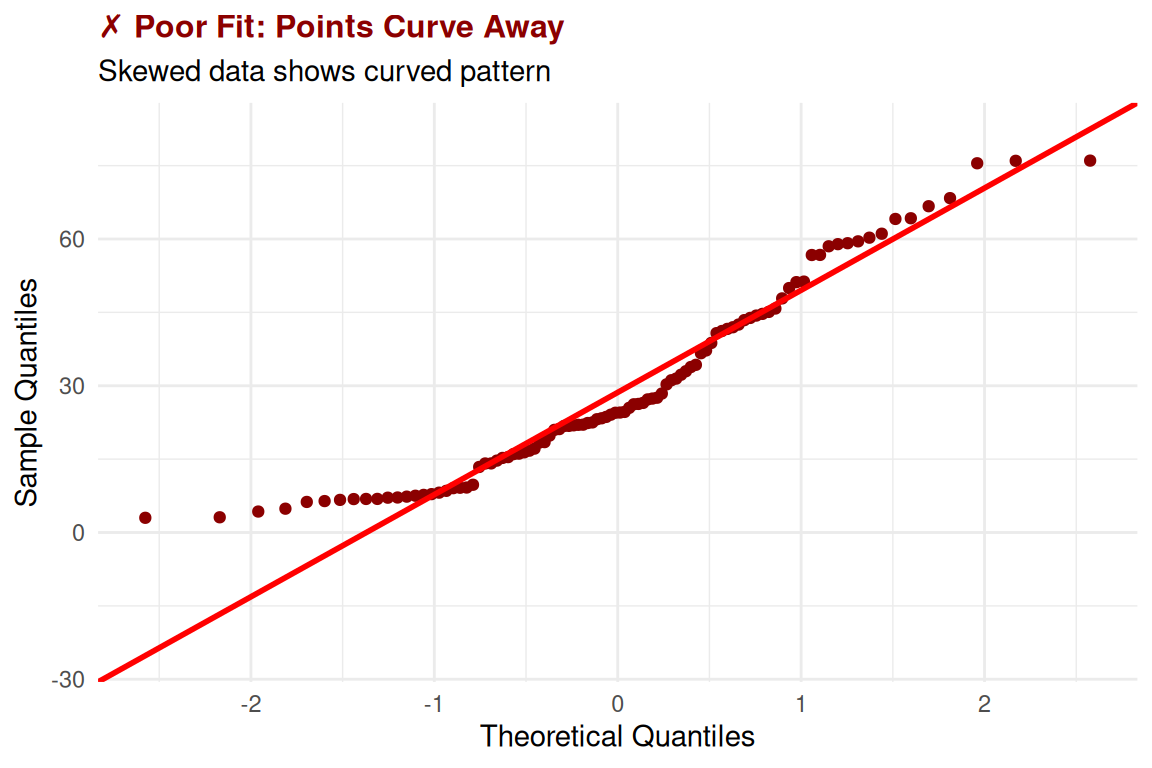
Q-Q Plot Detective Guide
Perfect Alignment (Points hug the red line)
- What it means: Your data follows a normal distribution
- Action: Safe to use normal-based statistical tests
Curved Patterns (Points form a smile or frown)
- What it means: Skewed data (right or left)
- Action: Consider log or square root transformation
S-Shaped Curves (Points make an S-curve)
- What it means: Heavy or light tails
- Action: Check for outliers or consider robust methods
Remember: The Q-Q plot is your normality lie detector test!
EPA Case Study: Detective Work in Action
Our Investigation Results:
Visual Evidence (The Smoking Gun)
- Histogram: Right skew detected!
- Q-Q plot: Points drift off diagonal in upper tail
- Boxplot: Outlier at 44.9 MPG waving red flag
Empirical Rule Check (Mixed Signals)
- 72% in μ±1σ (want 68%) → Close enough
- 95% in μ±2σ (perfect match) → Excellent
- 100% in μ±3σ (want 99.7%) → Slightly off
Quick Ratio Test (Confirmation)
- IQR/SD = 1.1 (want 1.3) → Light tails detected
Verdict: Mildly non-normal → Consider transformations for critical analyses
Test Your Detective Skills!
Your Turn! Look at this histogram and Q-Q plot:
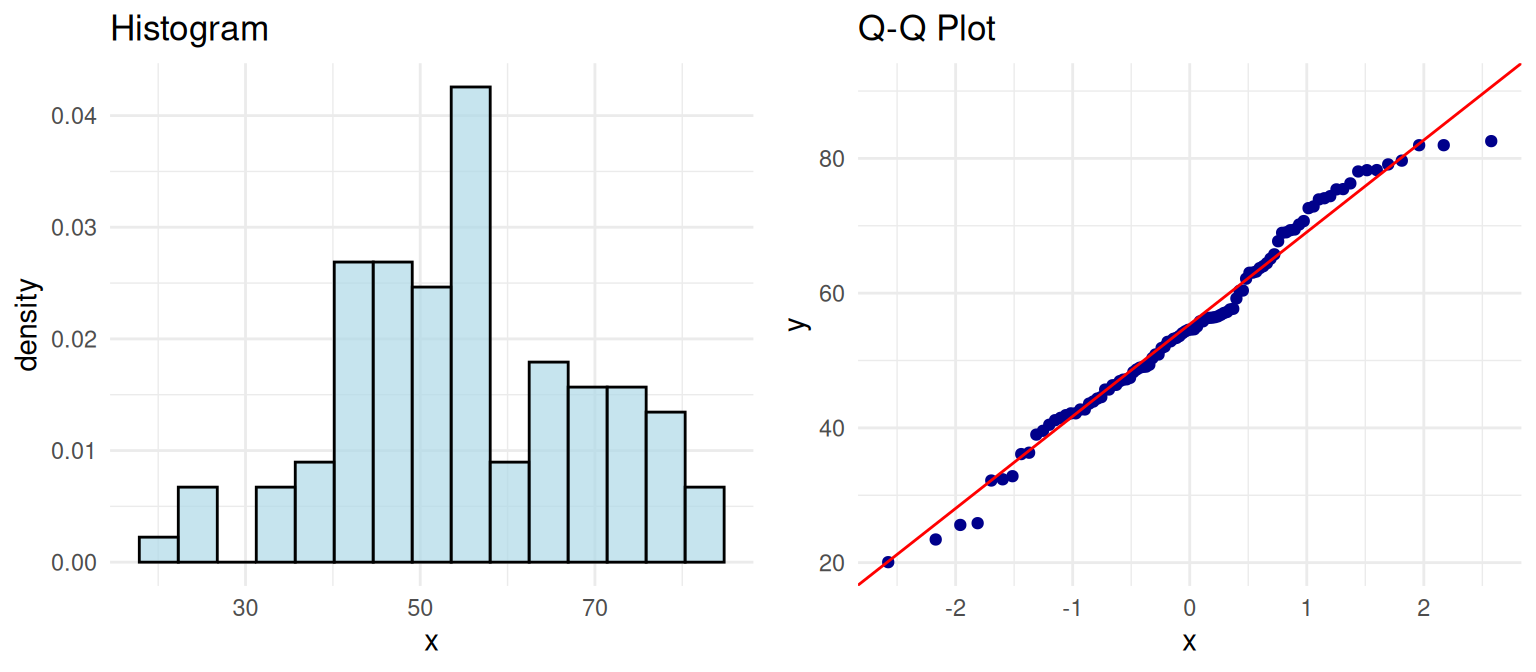
Question: Based on these plots, would you trust normal-based statistical tests for this data? Why or why not?
When Data Disappoints: The Transformation
The Problem: Your data isn’t normal → Normal-based tests are unreliable
The Solution: Transform the data to make it normal!
The Strategy: Try these transformations (in order):
- Square Root: Mild right skew
- Log: Moderate right skew
- Box-Cox: Let software find the best one
Remember: Always check normality AFTER transforming!
Transformation Success Story
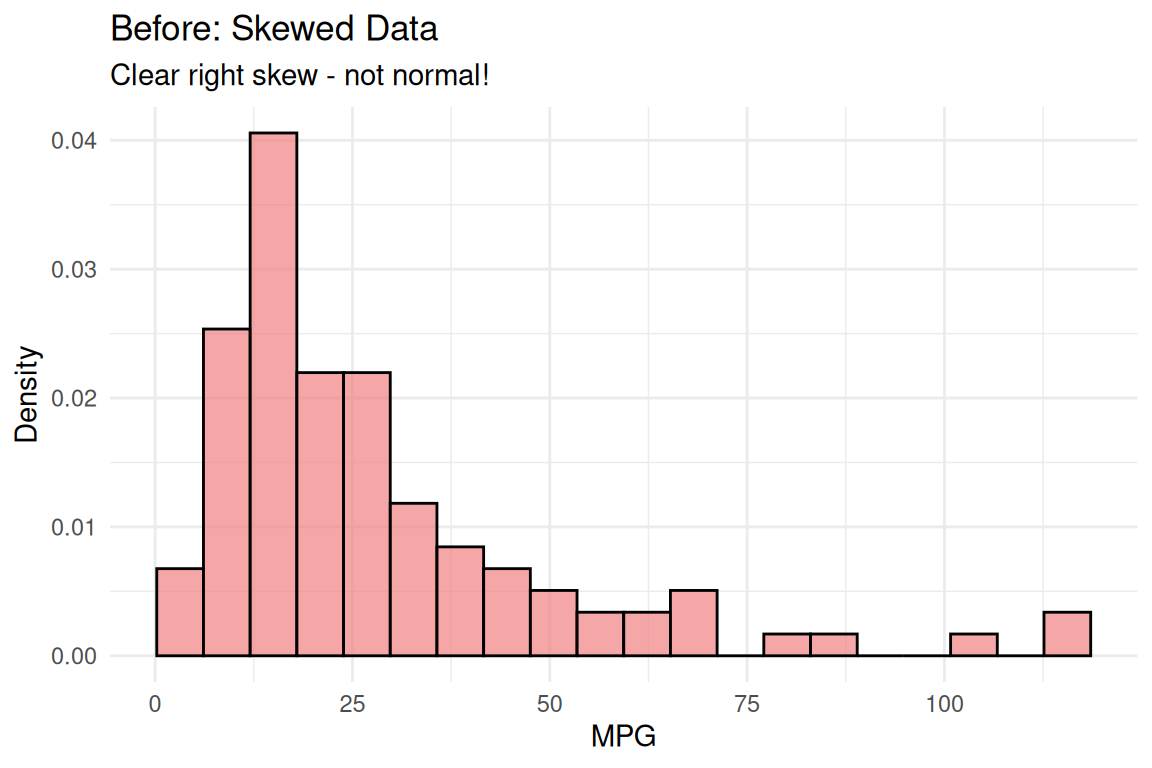
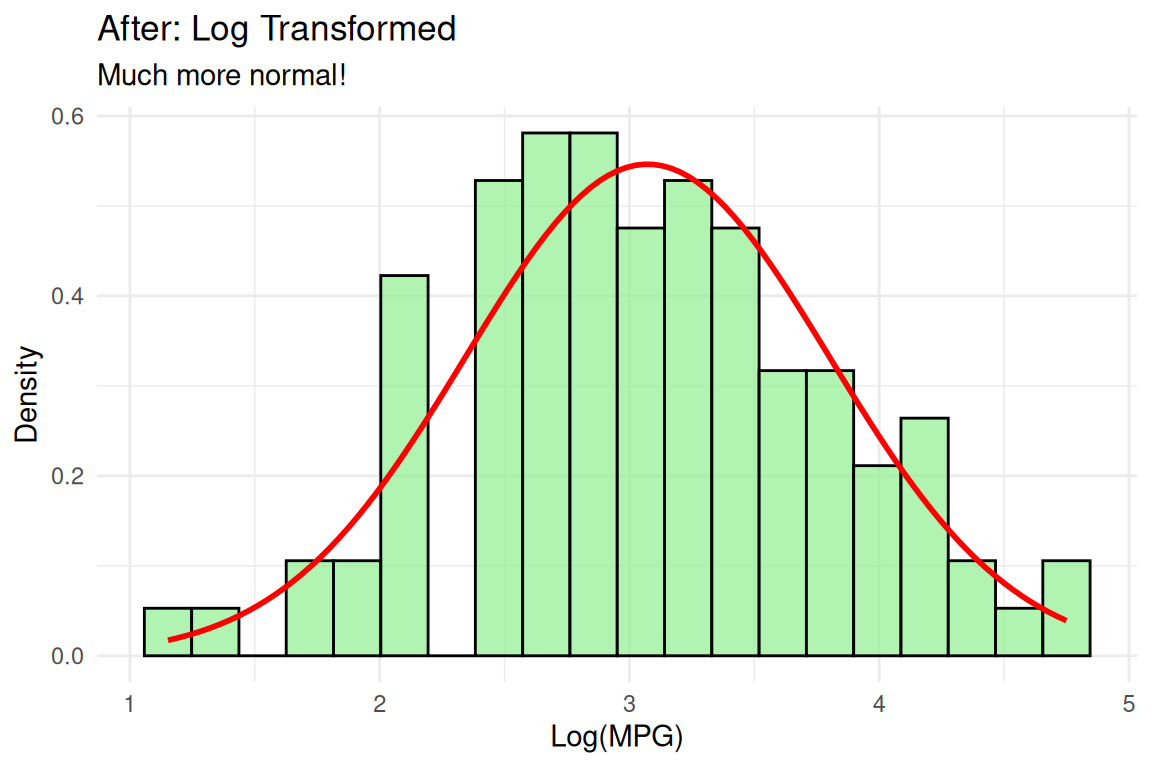
The Magic: Log transformation turned our skewed data into approximately normal data!
Result: Now we can safely use normal-based statistical tests on the transformed data.
Pro Tip: Always transform back to original scale for final interpretations.
Key Takeaways: Normality Toolkit
Master These Skills:
- Visual Detection: Spot skewed tails and asymmetric patterns
- 3-Step Test: Quick normality assessment in under 2 minutes
- Transformation Fix: Turn non-normal data into normal data
Quick Decision Rule:
- Clearly Normal → Use normal-based tests confidently
- Borderline/Unclear → Consider transformations or non-parametric alternatives
- Clearly Non-Normal → Transform or use non-parametric methods
